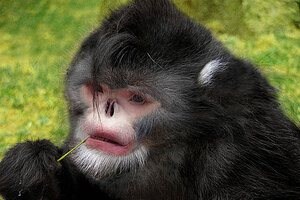Snub-nosed monkey can't stop sneezing when it rains
Snub-nosed monkey, newly discovered in a remote forest in Myanmar, has a nose that is upturned, causing it to sneeze whenever it rains.

A new type of snub-nosed monkey is seen in this undated handout of an artist rendering. The monkey, dubbed Rhinopithecus strykeri, been found in a remote forested region of northern Myanmar that is under threat from logging and a Chinese dam project, scientists said Wednesday.
Dr Thomas Geissmann/Fauna & Flora International/Reuters
Almost by definition, species unknown to science are often tough to track down. But researchers seeking out a new species of primate in northern Myanmar were assured by locals that the monkeys aren't hard to find at all. You just have to wait for it to rain.
The new species, a previously unknown type of snub-nosed monkey dubbed Rhinopithecus strykeri, has a nose so upturned that the animals sneeze audibly when it rains. To avoid inhaling water, the monkeys supposedly sit with their heads tucked between their knees on drizzly days, according to local hunters.
The discovery, reported today (Oct. 26) in the American Journal of Primatology, was made by biologists from the Myanmar Biodiversity and Nature Conservation Association and primatologists from Fauna and Flora International and the People Resources and Biodiversity Foundation.
The research team was working on a survey of gibbons in northeastern Myanmar in early 2010 when villagers told them about a monkey with an odd nose and prominent lips. Based on the descriptions, the researchers suspected the locals were seeing snub-nosed monkeys, threatened primates previously found only in China and Vietnam.
Intrigued, the team investigated further, surveying field sites and interviewing local villagers. The monkeys were well-known in the area, with villagers in 25 of 33 locations reporting monkey sightings. Several hunters provided skulls and hides from the monkeys, which have now been placed in museum collections in Switzerland and Myanmar.
After studying the specimens, the researchers realized they had a new species on their hands. The monkeys are about 21 inches (55 centimeters) long from upturned nose to rump, but their 30-inch (78 cm) tails more than double their length. Their fur is black with white ear tufts. Except for their white moustaches, the monkeys' faces are bare and pink.
The villagers in the area call the monkeys “myuk na tok te” or “mey nwoah,” both names meaning "monkey with an upturned nose," the researchers write. The monkeys themselves live in a mountainous area separated from other species by two rivers. Their range is probably no more than 167 square miles (270 square kilometers), and they likely number no more than 330. That makes the newly discovered monkey critically endangered by International Union for Conservation of Nature (IUCN) standards.
The monkeys are especially threatened by planned dam construction and logging roads in their habitat, the researchers report.
